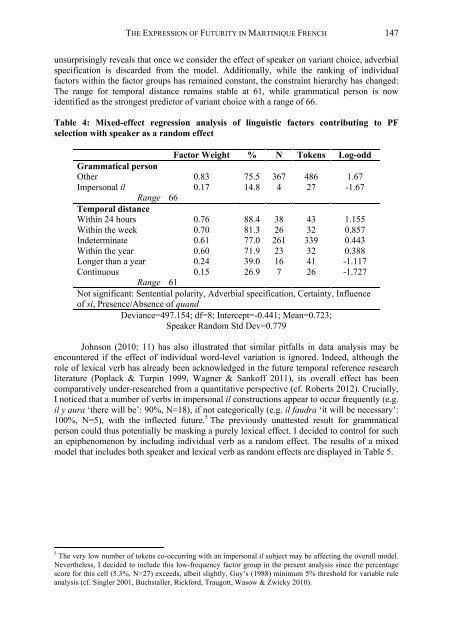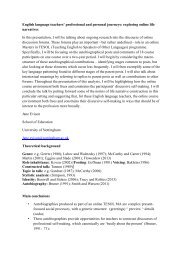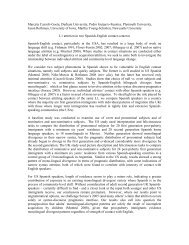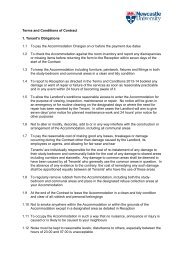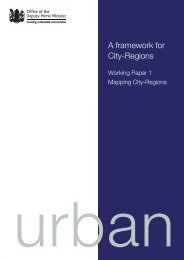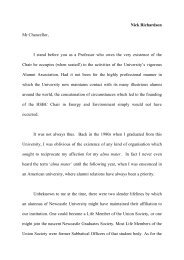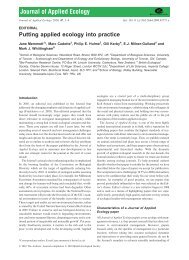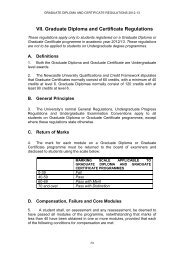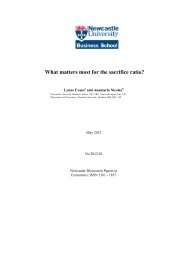the influence of linguistic factors on the expression of futurity
the influence of linguistic factors on the expression of futurity
the influence of linguistic factors on the expression of futurity
You also want an ePaper? Increase the reach of your titles
YUMPU automatically turns print PDFs into web optimized ePapers that Google loves.
THE EXPRESSION OF FUTURITY IN MARTINIQUE FRENCH 147<br />
unsurprisingly reveals that <strong>on</strong>ce we c<strong>on</strong>sider <str<strong>on</strong>g>the</str<strong>on</strong>g> effect <str<strong>on</strong>g>of</str<strong>on</strong>g> speaker <strong>on</strong> variant choice, adverbial<br />
specificati<strong>on</strong> is discarded from <str<strong>on</strong>g>the</str<strong>on</strong>g> model. Additi<strong>on</strong>ally, while <str<strong>on</strong>g>the</str<strong>on</strong>g> ranking <str<strong>on</strong>g>of</str<strong>on</strong>g> individual<br />
<str<strong>on</strong>g>factors</str<strong>on</strong>g> within <str<strong>on</strong>g>the</str<strong>on</strong>g> factor groups has remained c<strong>on</strong>stant, <str<strong>on</strong>g>the</str<strong>on</strong>g> c<strong>on</strong>straint hierarchy has changed:<br />
The range for temporal distance remains stable at 61, while grammatical pers<strong>on</strong> is now<br />
identified as <str<strong>on</strong>g>the</str<strong>on</strong>g> str<strong>on</strong>gest predictor <str<strong>on</strong>g>of</str<strong>on</strong>g> variant choice with a range <str<strong>on</strong>g>of</str<strong>on</strong>g> 66.<br />
Table 4: Mixed-effect regressi<strong>on</strong> analysis <str<strong>on</strong>g>of</str<strong>on</strong>g> <str<strong>on</strong>g>linguistic</str<strong>on</strong>g> <str<strong>on</strong>g>factors</str<strong>on</strong>g> c<strong>on</strong>tributing to PF<br />
selecti<strong>on</strong> with speaker as a random effect<br />
Factor Weight % N Tokens Log-odd<br />
Grammatical pers<strong>on</strong><br />
O<str<strong>on</strong>g>the</str<strong>on</strong>g>r 0.83 75.5 367 486 1.67<br />
Impers<strong>on</strong>al il 0.17 14.8 4 27 -1.67<br />
Range 66<br />
Temporal distance<br />
Within 24 hours 0.76 88.4 38 43 1.155<br />
Within <str<strong>on</strong>g>the</str<strong>on</strong>g> week 0.70 81.3 26 32 0.857<br />
Indeterminate 0.61 77.0 261 339 0.443<br />
Within <str<strong>on</strong>g>the</str<strong>on</strong>g> year 0.60 71.9 23 32 0.388<br />
L<strong>on</strong>ger than a year 0.24 39.0 16 41 -1.117<br />
C<strong>on</strong>tinuous 0.15 26.9 7 26 -1.727<br />
Range 61<br />
Not significant: Sentential polarity, Adverbial specificati<strong>on</strong>, Certainty, Influence<br />
<str<strong>on</strong>g>of</str<strong>on</strong>g> si, Presence/Absence <str<strong>on</strong>g>of</str<strong>on</strong>g> quand<br />
Deviance=497.154; df=8; Intercept=-0.441; Mean=0.723;<br />
Speaker Random Std Dev=0.779<br />
Johns<strong>on</strong> (2010: 11) has also illustrated that similar pitfalls in data analysis may be<br />
encountered if <str<strong>on</strong>g>the</str<strong>on</strong>g> effect <str<strong>on</strong>g>of</str<strong>on</strong>g> individual word-level variati<strong>on</strong> is ignored. Indeed, although <str<strong>on</strong>g>the</str<strong>on</strong>g><br />
role <str<strong>on</strong>g>of</str<strong>on</strong>g> lexical verb has already been acknowledged in <str<strong>on</strong>g>the</str<strong>on</strong>g> future temporal reference research<br />
literature (Poplack & Turpin 1999, Wagner & Sank<str<strong>on</strong>g>of</str<strong>on</strong>g>f 2011), its overall effect has been<br />
comparatively under-researched from a quantitative perspective (cf. Roberts 2012). Crucially,<br />
I noticed that a number <str<strong>on</strong>g>of</str<strong>on</strong>g> verbs in impers<strong>on</strong>al il c<strong>on</strong>structi<strong>on</strong>s appear to occur frequently (e.g.<br />
il y aura ‘<str<strong>on</strong>g>the</str<strong>on</strong>g>re will be’: 90%, N=18), if not categorically (e.g. il faudra ‘it will be necessary’:<br />
100%, N=5), with <str<strong>on</strong>g>the</str<strong>on</strong>g> inflected future. 5 The previously unattested result for grammatical<br />
pers<strong>on</strong> could thus potentially be masking a purely lexical effect. I decided to c<strong>on</strong>trol for such<br />
an epiphenomen<strong>on</strong> by including individual verb as a random effect. The results <str<strong>on</strong>g>of</str<strong>on</strong>g> a mixed<br />
model that includes both speaker and lexical verb as random effects are displayed in Table 5.<br />
5 The very low number <str<strong>on</strong>g>of</str<strong>on</strong>g> tokens co-occurring with an impers<strong>on</strong>al il subject may be affecting <str<strong>on</strong>g>the</str<strong>on</strong>g> overall model.<br />
Never<str<strong>on</strong>g>the</str<strong>on</strong>g>less, I decided to include this low-frequency factor group in <str<strong>on</strong>g>the</str<strong>on</strong>g> present analysis since <str<strong>on</strong>g>the</str<strong>on</strong>g> percentage<br />
score for this cell (5.3%, N=27) exceeds, albeit slightly, Guy’s (1988) minimum 5% threshold for variable rule<br />
analysis (cf. Singler 2001, Buchstaller, Rickford, Traugott, Wasow & Zwicky 2010).


